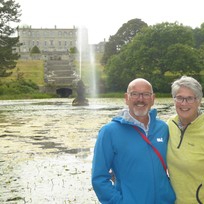( Overview
/ Two Bullocks on a Boat in Eire
Another day with very high winds and seas, so we caught the bus to Killruddery House, home of the Brabazon Family (Earls of Meath).
Not sure what these little ‘houses’ are about on the walk through the woods back to the bus stop, but we rather liked the name on this one!
In the walled garden, fruit and vegetables are grown and there is a farm on the 800 acre estate. These provide ingredients to the restaurant.
The formal gardens, which are the oldest in Ireland, surviving in their original 17th century form.
Of course, Killruddery House has also been used as a shooting location for films and TV, including ‘My Left Foot’, ‘Becoming Jane’ and more recently, ‘The Turning’.
The long ponds are twin canals 187 metres long, and used to ‘store’ fish for the house to eat. The grounds also have an 18th Century Sylvan, or greenery, theatre.
On a tour of the house, we discovered the original front of the house was removed (by two men and a donkey and cart) in the 1950’s because of dry rot.
Materials were often hard to come by, so he made this clock from an old table top, warming pan and a pot purloined from the kitchen.
In the 1820s the 10th Earl engaged the fashionable architects, Richard and William Morrison, to remodel Killruddery.
This portrait of Charles 11, king at the time the original hunting lodge was built, made us smile. Apparently it was damaged in a fire, and an ‘artist’ in the family touched it up.
The Orangery was built in 1852 after the fashion of Crystal Palace, London. The 11th and 12th Earls also constructed houses for workers in the Liberties area of Dublin, which remained in the families even after the employee died.
Apparently when the 11th Earl objected to spending more money on building the Orangery, his countess Harriet sold the family tiara to finance the work. The crenellations were consequently based on the design of the tiara.
































 Sign in with Apple
Sign in with Apple  Log in with Facebook
Log in with Facebook